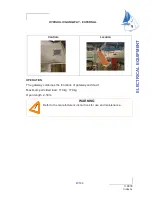
5
6
Risk of serious injury or death from drowning.
Paddle sports can be very dangerous and physically demanding.
The user of this product acknowledges and understands an assumption of the
risks involved in paddle sports.
Observe the following safety standards and safe operating practices whenever
using this product.
• Read this owner’s safety manual prior to using this product.
• Always wear a coast guard approved personal flotation device.
• Do not exceed maximum weight capacity. Regardless of number of persons
on board, total weight of persons and equipment must not exceed maximum
weight capacity.
• Do not operate the kayak under the influence of drugs or alcohol or any other
impairment or disability.
• Wear a helmet where appropriate.
• Do not use this product under the influence of alcohol or drugs.
• Do not paddle alone.
• Children must be supervised by a responsible adult at all times.
• Dress appropriately for weather and marine conditions; cold water and/or
weather can result in hypothermia.
• Beware of offshore winds and currents, they could take you out to sea.
• Check weather forecasts and obtain local knowledge of marine environment and
weather conditions prior to your voyage.
• Do not exceed your paddling ability; be aware of your limitations.
• Obtain paddle sports instructions specific to this type of craft. Proper instruction
will make your paddling experience safer and more enjoyable (Information on
paddling can be obtained from your dealer or from the American Canoe Associa
-
tion at WWW.AMERICANCANOE.ORG).
• Consult your physician prior to beginning your paddle sports training.
• Obtain certified first aid and CPR training, and carry appropriate first aid, rescue
and safety equipment (see SAFETY EQUIPMENT).
• Be aware of appropriate river water levels, tidal changes, currents, and ob
-
stacles in and above the water.
• Check your equipment prior to each use for signs of wear, leaks or failure.
• Tie a leash to your paddle when appropriate.
• Always inform someone of your paddling route, the time and location of your
departure and your intended time and location of arrival.
• Always carry identification.
• Do not paddle in flood conditions.
• Make sure you are able to exit the craft if necessary.
• Scout unfamiliar waters; portage where appropriate.
• Carry, read, and understand navigation charts when approptiate.
• Observe right-of-way as defined by “Rules of the Road” and required by COL
-
REGS.
• Obey signs for restricted areas designated for swimming, bathing or other forms
of recreation.
• Learn to control your craft and know the limitations of your capabilities and the
capabilities of your craft. If necessary take a paddling course to learn these
limitations.
• Inform someone of your Float Plan including time and place of departure, pro
-
posed route and expected time of return.
WARNING
CAUTION
CAUTION
OPERATOR INSTRUCTIONS & NAVIGATION





































